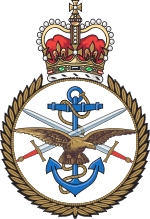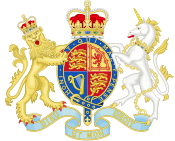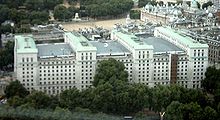- Ministry of Defence (United Kingdom)
-
United Kingdom
Ministry of Defence
Ministry of Defence Combined Services badge Department overview Formed 1964 (As modern department) Jurisdiction United Kingdom Headquarters Whitehall, Westminster, London[1] Employees Over 80,000 civilian staff[2] Annual budget £35.165 billion (2009/10)[3] Minister responsible Philip Hammond, Secretary of State for Defence Department executives General Sir David Richards, Chief of the Defence Staff
Ursula Brennan, Permanent SecretaryWebsite http://www.mod.uk United Kingdom 
This article is part of the series:
Politics and government of
the United KingdomGovernment- Sovereign
- Queen Elizabeth II
- The Crown
- Royal Prerogative
- Privy Council
- Cabinet
- Her Majesty's Civil Service
Foreign policy
The Ministry of Defence (MoD) is the United Kingdom government department responsible for implementation of government defence policy and is the headquarters of the British Armed Forces.
The MoD states that its principal objectives are to defend the United Kingdom and its interests and to strengthen international peace and stability.[4] With the collapse of the Soviet Union and the end of the Cold War, the MoD does not foresee any short-term conventional military threat; rather, it has identified weapons of mass destruction, international terrorism, and failed and failing states as the overriding threats to the UK's interests.[5] The MoD also manages day to day running of the armed forces, contingency planning and defence procurement.
Contents
History
During the 1920s and 1930s, British civil servants and politicians, looking back at the performance of the state during World War I, concluded that there was a need for greater co-ordination between the three Services that made up the armed forces of the United Kingdom—the British Army, the Royal Navy, and the Royal Air Force. The formation of a united ministry of defence was rejected by Prime Minister David Lloyd George's coalition government in 1921; but the Chiefs of Staff Committee was formed in 1923, for the purposes of inter-Service co-ordination. As rearmament became a concern during the 1930s, Stanley Baldwin created the position of Minister for Coordination of Defence. Lord Chatfield held the post until the fall of Neville Chamberlain's government in 1940; his success was limited by his lack of control over the existing Service departments and his limited political influence.
Winston Churchill, on forming his government in 1940, created the office of Minister of Defence to exercise ministerial control over the Chiefs of Staff Committee and to co-ordinate defence matters. The post was held by the Prime Minister of the day until Clement Attlee's government introduced the Ministry of Defence Act of 1946. The new ministry was headed by a Minister of Defence who possessed a seat in the Cabinet. The three existing service Ministers — the Secretary of State for War, the First Lord of the Admiralty, and the Secretary of State for Air — remained in direct operational control of their respective services, but ceased to attend Cabinet.
From 1946 to 1964 five Departments of State did the work of the modern Ministry of Defence: the Admiralty, the War Office, the Air Ministry, the Ministry of Aviation, and an earlier form of the Ministry of Defence. These departments merged in 1964; the defence functions of the Ministry of Aviation Supply merged into the Ministry of Defence in 1971.[6]
Ministers
The Ministers in the Ministry of Defence are as follows:[7]
Minister Rank Portfolio The Rt Hon Philip Hammond MP Secretary of State Overall responsibility and strategic direction Nick Harvey MP Minister of State Armed forces, operations Gerald Howarth MP Parliamentary Under-Secretary of State International security strategy, defence exports The Rt Hon Andrew Robathan MP Parliamentary Under-Secretary of State Defence personnel, welfare and veterans Peter Luff MP Parliamentary Under-Secretary of State Defence equipment, support and technology Lord Astor of Hever DL Parliamentary Under-Secretary of State Lords spokesman Key Conservative Liberal Democrat Senior officials
Permanent Secretaries and other senior officials
The Ministers and Chiefs of the Defence Staff are supported by a number of civilian, scientific and professional military advisors. The Permanent Under-Secretary of State for Defence (generally known as the Permanent Secretary) is the senior civil servant at the MoD. Her role is to ensure the MoD operates effectively as a department of the government.
- Permanent Under-Secretary of State — Ursula Brennan[8]
- Second Permanent Under-Secretary of State — Jon Day
- Chief of Defence Materiel — Bernard Gray
- Chief Scientific Adviser — Professor Mark Welland
- Director General Finance — Jon Thompson
Chiefs of the Defence Staff
The current Chief of the Defence Staff, the professional head of the British Armed Forces, is General Sir David Richards, British Army. He is supported by the Vice Chief of the Defence Staff and by the professional heads of the three services of HM Armed Forces.
- Vice-Chief of the Defence Staff — General Sir Nicholas Houghton, British Army.
- First Sea Lord and Chief of the Naval Staff — Admiral Sir Mark Stanhope, Royal Navy
- Chief of the General Staff — General Sir Peter Wall, British Army.
- Chief of the Air Staff — Air Chief Marshal Sir Stephen Dalton, Royal Air Force
There are also three Deputy Chiefs of the Defence Staff with particular remits, Deputy Chief of the Defence Staff (Capability), Deputy CDS (Personnel and Training) and Deputy CDS (Operations). The Surgeon General, represents the Defence Medical Services on the Defence Staff, and is the clinical head of that service.[9] Additionally, there are a number of Assistant Chiefs of Defence Staff, including the Defence Services Secretary in the Royal Household of the Sovereign of the United Kingdom, who is also the Assistant Chief of Defence Staff (Personnel).[10]
Defence policy
The 1998 Strategic Defence Review and the 2003 Delivering Security in a Changing World White Paper outlined the following posture for the British Armed Forces:
- The ability to support three simultaneous small- to medium-scale operations, with at least one as an enduring peace-keeping mission (e.g. Kosovo). These forces must be capable of representing the UK as lead nation in any coalition operations.
- The ability, at longer notice, to deploy forces in a large-scale operation while running a concurrent small-scale operation.
The MOD has since been regarded as a leader in elaborating the post-Cold War organising concept of “Defence Diplomacy”.[11][12][13]
In November 2010, the MOD released its first ever business plan.[14][15]
Perceived current threats
Following the end of the cold war, the perceived threat of direct conventional military confrontation with other states has been replaced by terrorism - Sir Richard Dannatt predicted British forces to be involved in combating "predatory non-state actors" for the foreseeable future, in what he called an "era of persistent conflict".[16] He told the prestigious think tank Chatham House that the fight against al-Qaeda and other militant Islamist groups was "probably the fight of our generation".[16]
Sir Richard Dannatt criticised a remnant "Cold War mentality", with military expenditures based on retaining a capability against a direct conventional strategic threat;[16][17] He said currently only 10% of the MoD's equipment programme budget between 2003 and 2018 was to be invested in the "land environment" - at a time when Britain was engaged in land-based wars in Afghanistan and Iraq.[16]
The Defence Committee - Third Report "Defence Equipment 2009"[18] cites an article from the Financial Times website[19] stating that the Chief of Defence Materiel — General Sir Kevin O’Donoghue had instructed staff within Defence Equipment and Support (DE&S) through an internal memorandum to reprioritize the approvals process to focus on supporting current operations over the next three years; deterrence related programmes; those that reflect defence obligations both contractual or international; and those where production contracts are already signed. The report also cites concerns over potential cuts in the defence science and technology research budget; implications of inappropriate estimation of Defence Inflation within budgetary processes; underfunding in the Equipment Programme; and a general concern over striking the appropriate balance over a short-term focus (Current Operations) and long-term consequences of failure to invest in the delivery of future UK defence capabilities on future combatants and campaigns.[18] The then Secretary of State for Defence — The Rt Hon. Bob Ainsworth, MP reinforced this reprioritization of focus on current operations and had not ruled out "major shifts" in defence spending.[20] In the same article the First Sea Lord and Chief of the Naval Staff — Admiral Sir Mark Stanhope, Royal Navy, acknowledged that there was not enough money within the defence budget and it is preparing itself for tough decisions and the potential for cutbacks.[20] According to figures published by the London Evening Standard[21] the defence budget for 2009 is "more than 10% overspent" (figures cannot be verified) and the paper states that this had caused Gordon Brown to say that the defence spending must be cut. The MoD has been investing in IT [22] to cut costs and improve services for its personnel.[23][24]
Departmental Organisation
The Ministry of Defence includes a number of organisations:
Top Level Budget holder organisations:[25]
- Navy Command
- Land Forces
- Air Command
- Central TLB
- Chief of Joint Operations
- Defence Equipment and Support
- Defence Infrastructure Organisation
Executive Agencies:
- Defence Vetting Agency
- Ministry of Defence Police and Guarding Agency, which includes the Ministry of Defence Police
- People, Pay and Pensions Agency
- Service Children's Education
- Service Personnel and Veterans Agency
Trading Funds:[26]
Non-departmental public bodies:
For many years the Met Office was a trading fund of the Ministry of Defence, however on 18 July 2011 it was transferred to the Department for Business, Innovation and Skills.[27]
Property portfolio
The Ministry of Defence is one of the United Kingdom's largest landowners owning, as of January 2010, 240,000 hectares (2,400 square kilometres) which were valued in 2009 at "nearly £20 billion". The MOD also has "rights of access" to a further 130,000 hectares. The National Audit Office estimates annual expenditure on the defence estate at £2.9 billion.[28]
The defence estate is divided as training areas & ranges (78.1%), airfields (7%), research & development (4.9%), storage & depots (3.1%), barracks & camps (3.1%), miscellaneous (1.8%), radio sites (1.7%), and naval bases (0.3%). These are largely managed by the Defence Infrastructure Organisation.[28]
The headquarters of the MoD are in Whitehall and are now known as Main Building. This structure is neoclassical in style and was originally built between 1938 and 1959 to designs by Vincent Harris to house the Air Ministry and the Board of Trade. The northern entrance in Horse Guards Avenue is flanked by two monumental statues, Earth and Water, by Charles Wheeler. Opposite stands the Ghurka Monument, sculpted by Philip Jackson and unveiled in 1997 by Queen Elizabeth II. Within it is the Victoria Cross and George Cross Memorial, and nearby are memorials to the Fleet Air Arm and RAF (to its east, facing the riverside). A major refurbishment of the building was completed under a PFI contract by Skanska in 2004.[29]
Henry VIII's wine cellar at the Palace of Whitehall, built in 1514–1516, is in the basement of Main Building, and is used for entertainment. The entire arched brick structure of the cellar was moved a short distance in 1949.[30]
Fraud
Main article: Gordon FoxleyThe most notable fraud conviction was that of Gordon Foxley, head of defence procurement at the Ministry of Defence from 1981 to 1984. Police claimed he received at least £3.5m[31] in total in corrupt payments substantial bribes from overseas arms contractors aiming to influence the allocation of contracts.
Criticism
Chinook HC3 helicopters
The MoD has been criticised for an ongoing fiasco, having spent £240m on eight Chinook HC3 helicopters which only started to enter service in 2010, years after they were ordered in 1995 and delivered in 2001.[32] A National Audit Office report reveals that the helicopters have been stored in air conditioned hangars in Britain since their 2001 delivery, while troops in Afghanistan have been forced to rely on helicopters which are flying with safety faults.[33] By the time the Chinooks are airworthy, the total cost of the project could be as much as £500m.[32]
“ ...the most incompetent procurement of all time...might as well have bought eight turkeys. ” In April 2008, a £90m contract was signed with Boeing for a "quick fix" solution, so they can fly by 2010: QinetiQ will downgrade the Chinooks - stripping out some of their more advanced equipment.[34]
Volunteer army cuts
In October 2009, the MoD was heavily criticized for withdrawing the bi-annual non-operational training £20m budget for the volunteer Territorial Army (TA), ending all non-operational training for 6 months until April 2010. The government eventually backed down and restored the funding. The TA provides a small percentage of the UK's operational troops. Its members train on weekly evenings and monthly weekends, as well as two week exercises generally annually and occasionally bi-annually for troops doing other courses. The cuts would have meant a significant loss of personnel and would have had adverse effects on recruitment.[35]
See also
- Defence Diplomacy
- Defence Review
- Franco-British Defence and Security Cooperation Treaty and Downing Street Declaration
- Gordon Foxley
- Stabilisation Unit
- United Kingdom budget
Notes
- ^ 51°30′14″N 0°7′30″W / 51.50389°N 0.125°W
- ^ "Defence in the Community". Ministry of Defence. http://www.mod.uk/DefenceInternet/AboutDefence/Organisation/KeyFactsAboutDefence/DefenceInTheCommunity.htm. Retrieved 22 March 2010.
- ^ "Defence Spending". Ministry of Defence. http://www.mod.uk/DefenceInternet/AboutDefence/Organisation/KeyFactsAboutDefence/DefenceSpending.htm. Retrieved 22 March 2010.
- ^ The Defence Vision Ministry of Defence website, accessed 23 April 2006.
- ^ Strategic Defence Review 1998 Ministry of Defence, accessed 8th December 2008.
- ^ History of the Ministry of Defence Ministry of Defence website
- ^ Cabinet Office List of Government Departments and Ministers: Ministry of Defence
- ^ Mod.uk
- ^ Mod.uk
- ^ Mod.uk
- ^ Mod.uk
- ^ Afri-ct.org
- ^ Spectator.co.uk
- ^ "Business Plan 2011-2015 - Ministry of Defence". 2010-11-08. http://www.mod.uk/NR/rdonlyres/88EA12B8-E08F-4EE4-9963-AFF82DBC665B/0/20101108_mod_business_plan_final.pdf. Retrieved 2010-11-09.
- ^ "2010-11-09". http://www.defenseindustrydaily.com/Rapid-Fire-2010-11-9-06634/. Retrieved 2010-11-09.
- ^ a b c d "MoD 'must adapt' to new threats". BBC. 2009-05-15. http://news.bbc.co.uk/1/hi/uk/8052790.stm. Retrieved 2009-06-23.
- ^ Monbiot, George (2009-06-22). "Any real effort on climate change will hurt - Start with the easy bits: war toys Our brains struggle with big, painful change. The rational, least painful change is to stop wasting money building tanks". The Guardian (London). http://www.guardian.co.uk/commentisfree/2009/jun/22/debt-crisis-environment-defence-spending. Retrieved 2009-06-23.
- ^ a b Defence Committee - Third Report - Defence Equipment 2009
- ^ "MoD orders spending clampdown", Financial Times, 16 November 2008, FT.com
- ^ a b Head of Royal Navy tells Government not to cut ships Friday, September 18, 2009, 11:30
- ^ Defence cuts 'to leave aircraft carriers without any planes', Robert Fox, 23.06.09
- ^ Ministry of Defence
- ^ MoD march out HR system firing at savings
- ^ Virus attacks Ministry of Defence
- ^ Mod.uk
- ^ Mod.uk
- ^ Met Office becomes part of the BIS family
- ^ a b NAO.org.uk
- ^ Better Defence Builds Project Case Study
- ^ History of MOD Main Building on Ministry of Defence website
- ^ "Mr. Mike Hall (Warrington, South)". Parliament of England. http://www.publications.parliament.uk/pa/cm199596/cmhansrd/vo961016/debtext/61016-37.htm. Retrieved 2008-01-19.
- ^ a b Hencke, David (4 June 2008). "Chinook blunders cost MoD £500m". The Guardian (London). http://www.guardian.co.uk/uk/2008/jun/04/military.defence?gusrc=rss&feed=networkfront. Retrieved 2008-06-04.
- ^ "National Audit Office Value for Money Report: Executive Summary - Ministry of Defence: Chinook Mk3 Helicopters". NAO. http://www.nao.org.uk/publications/nao_reports/07-08/0708512es.pdf. Retrieved 2008-06-04.
- ^ a b "MoD sorts out 'turkey' helicopters for Xmas". The Register. http://www.theregister.co.uk/2007/12/20/chinook_hc3_cockup_finally_resolved_turkeys_fly_at_last/. Retrieved 2008-06-04.
- ^ Cuts force TA to cease training BBC News, 10 October 2009
References
- Chester, D. N and Willson, F. M. G. The Organisation of British Central Government 1914–1964: Chapters VI and X (2nd edition). London: George Allen & Unwin, 1968.
External links
Video clips
United Kingdom Ministry of Defence Headquarters: Main Building, Palace of Whitehall Armed Forces Defence Council Secretary of State for Defence · Minister of State for the Armed Forces · Parliamentary Under-Secretary of State and Minister for Defence Equipment, Support and Technology · Minister for International Security Strategy · Parliamentary Under-Secretary of State for Defence and Minister for VeteransService boards Executive agencies  CategoryCategories:
CategoryCategories:- Ministerial departments of the United Kingdom Government
- Defence ministries
- Veterans' affairs ministries
- Ministry of Defence (United Kingdom)
- Military of the United Kingdom
- Military units and formations established in 1964
- Ministries established in 1964
- 1964 establishments in the United Kingdom
- Sovereign
Wikimedia Foundation. 2010.





